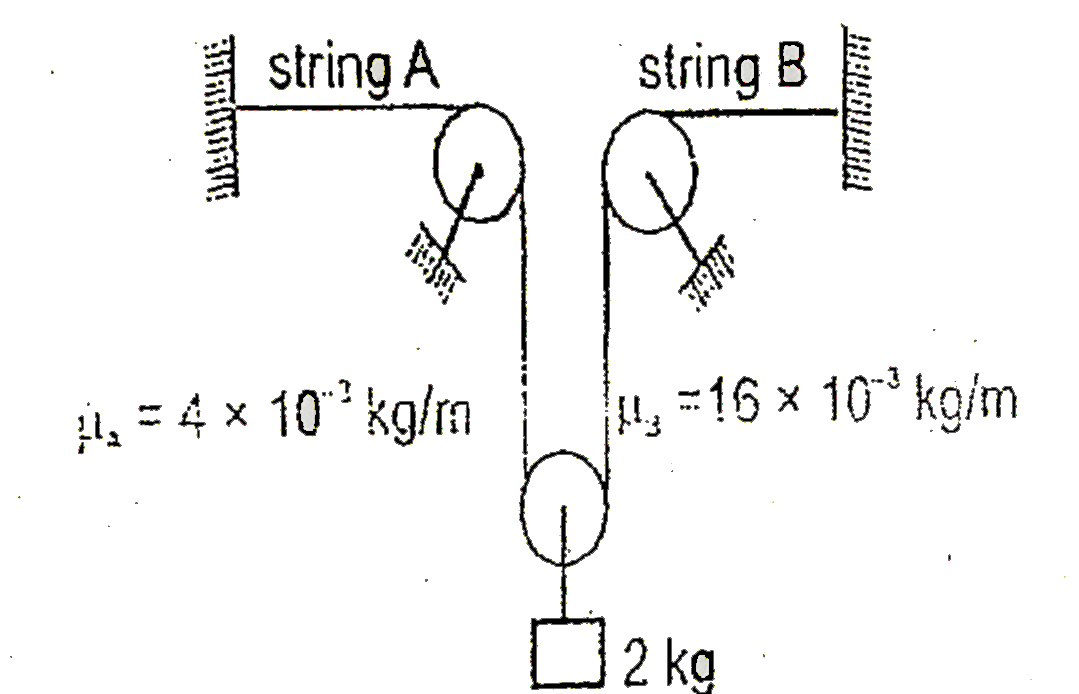The velocity of waves in a string fixed at both ends is 2 m / s . The string forms standing waves with nodes 5.0 cm apart. The frequency of vibration of the string in Hz is
The correct Answer is:20
To solve the problem step by step, we will follow these calculations:
1. Identify the given values:
- Velocity of the wave (v) = 2 m/s
- Distance between nodes = 5 cm
2. Convert the distance between nodes to meters:
- Since 1 cm = 0.01 m, we convert 5 cm to meters:
5 cm=5×0.01 m=0.05 m
3. Relate the distance between nodes to the wavelength (λ):
- For standing waves on a string fixed at both ends, the distance between two consecutive nodes is half the wavelength (λ/2).
- Therefore, we can express this as:
λ2=0.05 m
4. Calculate the wavelength (λ):
- To find λ, we multiply both sides of the equation by 2:
λ=2×0.05 m=0.10 m
5. Use the wave speed formula to find the frequency (f):
- The relationship between wave speed (v), frequency (f), and wavelength (λ) is given by:
v=fλ
- Rearranging this formula to solve for frequency gives:
f=vλ
6. Substitute the known values into the frequency formula:
- Substitute v = 2 m/s and λ = 0.10 m:
f=2 m/s0.10 m=20 Hz
7. Conclusion:
- The frequency of vibration of the string is 20 Hz.
Summary of the Solution:
The frequency of vibration of the string is 20 Hz.
- Velocity of the wave (v) = 2 m/s
- Distance between nodes = 5 cm
- Since 1 cm = 0.01 m, we convert 5 cm to meters:
5 cm=5×0.01 m=0.05 m
- For standing waves on a string fixed at both ends, the distance between two consecutive nodes is half the wavelength (λ/2).
- Therefore, we can express this as:
λ2=0.05 m
- To find λ, we multiply both sides of the equation by 2:
λ=2×0.05 m=0.10 m
- The relationship between wave speed (v), frequency (f), and wavelength (λ) is given by:
v=fλ
- Rearranging this formula to solve for frequency gives:
f=vλ
- Substitute v = 2 m/s and λ = 0.10 m:
f=2 m/s0.10 m=20 Hz
- The frequency of vibration of the string is 20 Hz.
The frequency of vibration of the string is 20 Hz.
Topper's Solved these Questions
- BOOK - CENGAGE PHYSICS ENGLISHCHAPTER - SUPERPOSITION AND STANDING WAVESEXERCISE - Subjective Type2videos
SUPERPOSITION AND STANDING WAVES
- BOOK - CENGAGE PHYSICS ENGLISHCHAPTER - SUPERPOSITION AND STANDING WAVESEXERCISE - Comprehension Type5videos
SUPERPOSITION AND STANDING WAVES
- BOOK - CENGAGE PHYSICS ENGLISHCHAPTER - SUPERPOSITION AND STANDING WAVESEXERCISE - Multiple Correct Answers Type5videos
SUPERPOSITION AND STANDING WAVES
- BOOK - CENGAGE PHYSICS ENGLISHCHAPTER - SOUND WAVES AND DOPPLER EFFECTEXERCISE - Integer16videos
SOUND WAVES AND DOPPLER EFFECT
- BOOK - CENGAGE PHYSICS ENGLISHCHAPTER - THERMODYNAMICSEXERCISE - 241videos
THERMODYNAMICS
Similar Questions
Knowledge Check
- Question 1 - Select One
A string fixed at its both ends vibrates in 5 loops as shown in the figure. The total number of nodes and antinodes are respectively
 A5,6B6,5C7,4D4,7
A5,6B6,5C7,4D4,7
The equation of a standing wave in a string fixed at both its ends is given as y=2A sin kx cos ωt. The amplitude and frequency of a particle vibrating at the point of string midway between a node and an antinode is
View SolutionThe wave-function for a certain standing wave on a string fixed at both ends is y(x,t)=0.5sin(0.025πx)cos500t where x and y are in centimeters and t is seconds. The shortest possible length of the string is :
View SolutionEstimation of frequency of a wave forming a standing wave represented by y=Asinkxcost can be done if the speed and wavelength are known using speed=Frequency×wavelength . Speed of motion depends on the medium properties namely tension in string and mass per unit length of string . A string may vibrate with different frequencies . The corresponding wavelength should be related to the length of the string by a whole number for a string fixed at both ends . Answer the following questions:
A string fixed at both ends having a third overtone frequency of 200Hz while carrying a wave at a speed of 30ms−1 has a length ofView SolutionA string fixed at both ends, is vibrating in a particular mode of vibration. Vibration is such that a point on string is at maximum displacement and it is at a distance of one fourth of length of string from one end. The frequency of vibration in thus mode is 200Hz. What will be the frequency of vibration when it vibrates in next mode such that the same point is at maximum displacement?
View SolutionA string of mass 'm' and length l, fixed at both ends is vibrating in its fundamental mode. The maximum amplitude is 'a' and the tension in the string is 'T'. If the energy of vibrations of the string is π2a2TηL. Find η
View SolutionA 660 Hz tuning fork sets up vibration in a string clamped at both ends. The wave speed for a transverse wave on this string is 220ms−1 and the string vibrates in three loops. (a) Find the length of the string. (b) If the maximum amplitude of a particle is 0.5 cm, write a suitable equation describing the motion.
View SolutionThe vibrations from an 800 Hz tuning fork set up standing waves in a string clamped at both ends. The wave speed in the string is known to be 400m/s for the tension used. The standing wave is observed to have four antinodes. How long is the string?
View Solution


